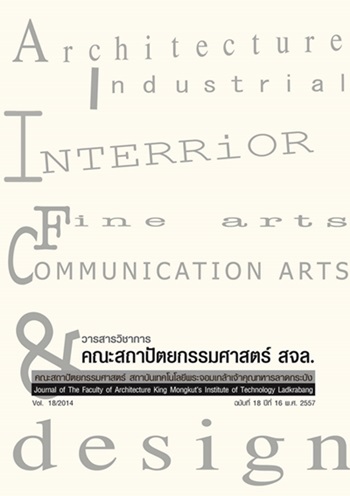การพัฒนาและประเมินผลบทเรียนคอมพิวเตอร์ช่วยสอนเรื่อง “พื้นฐานการถ่ายภาพ” ตามแนวคิดของโรเบิร์ต กาเย่ สำหรับนักเรียนชั้นประถม
Main Article Content
Abstract
บทคัดย่อ
จุดประสงค์ของงานวิจัยชิ้นนี้คือ เพื่อสร้างบทเรียนคอมพิวเตอร์ช่วยสอนเรื่อง “พื้นฐานการถ่ายภาพ” ตามแนวคิดของโรเบิร์ต กาเย่ ที่มีประสิทธิภาพตามเกณฑ์มาตรฐาน E1/E2 (80/80) และเพื่อเปรียบเทียบผลสัมฤทธิ์ทางการเรียนก่อนและหลังเรียนของนักเรียนชั้นประถมศึกษาปีที่ 6 กลุ่มตัวอย่างที่ใช้ศึกษาคือนักเรียนชั้นประถมศึกษาปีที่ 6 จำนวน100 คนของโรงเรียนแสงหิรัญวิทยา ลาดกระบัง โดยผู้วิจัยได้พัฒนาบทเรียนคอมพิวเตอร์ “พื้นฐานการถ่ายภาพ” สำหรับนักเรียนชั้นประถมขึ้น โดยดัดแปลงจากตำราเรียนวิชาพื้นฐานการถ่ายภาพของคณะสถาปัตยกรรมศาสตร์ และนำแนวคิดการพัฒนาบทเรียนจากโรเบิร์ต กาเย่ดังนี้ 1. เร่งเร้าความสนใจ 2. บอกวัตถุประสงค์ 3. ทบทวนความรู้เดิม 4. นำเสนอเนื้อหาใหม่ 5. ชี้แนะแนวทางการเรียนรู้ 6. กระตุ้นการตอบสนองบทเรียน 7. ให้ข้อมูลย้อนกลับ 8. ทดสอบความรู้ใหม่9. สรุปและนำไปใช้ สถิติที่ใช้หาประสิทธิภาพของบทเรียนคือ E1/E2 (80/80) และการทดสอบผลสัมฤทธิ์ก่อนและหลังเรียนใช้ค่าสถิติ Paired T-Test ผลการศึกษาพบว่าประสิทธิภาพของบทเรียนที่สร้างขึ้นมีค่าเฉลี่ยประสิทธิภาพ 86.75/87.00ซึ่งสูงกว่าเกณฑ์ที่กำหนดไว้ (80/80) และพบว่าผลสัมฤทธิ์ทางการเรียนหลังเรียนสูงกว่าก่อนเรียน อย่างมีนัยสำคัญทางสถิติที่ระดับ .05 ดังนั้นบทเรียนคอมพิวเตอร์ “พื้นฐานการถ่ายภาพ” สำหรับนักเรียนชั้นประถมชุดนี้สามารถนำไปใช้จัดการการเรียนการสอนสำหรับนักเรียนได้อย่างมีประสิทธิภาพ
คำสำคัญ: บทเรียนคอมพิวเตอร์ พื้นฐานการถ่ายภาพ โรงเรียนประถม นักเรียน
Abstract
The purpose of this study was to develop computer-assisted instruction in “Basic Photography” fromGagne’s instructional model for primary school students which had effectiveness of E1/E2 (80/80) accordingto standard criteria and to compare learning achievement of the primary school students before and afterstudying. This research samples were selected from 100 primary school students’ grade 6th of SanghirunWittaya, Ladkrabang. Additionally, this study develop a computer-assisted instruction by adapting from ‘BasicPhotography’ textbook of Architecture Department, KMITL and using Robert Gagne’s method: 1. Gain Attention,2. Specify Objective, 3. Activate Prior Knowledge, 4. Present New Information, 5. Guide Learning, 6. ElicitResponse, 7. Provide Feedback, 8. Assess Performance, 9. Review and Transfer. The standard score set toindicate the effectiveness of this teaching program using computer program analysis was at E1/E2 (80/80) andpaired t-test. The findings of this study revealed that the effectiveness of this computer-assisted instruction is86.75/87.00 higher than the standard criteria (80/80). Moreover, there was a significant difference of learningachievement after studying by computer assisted instruction higher than before at the .05 level of significant.In conclusion, this computer-assisted instruction as a learning tool for primary school students can enhanceknowledge on the topic ‘Basic Photography’ effectively.
Keywords: Computer-Assisted Instruction Basic Photography Primary School Student
Article Details
This work is licensed under a Creative Commons Attribution-NonCommercial-ShareAlike 4.0 International License.
Copyright Transfer Statement
The copyright of this article is transferred to Journal of The Faculty of Architecture King Mongkut's Institute of Technology Ladkrabang with effect if and when the article is accepted for publication. The copyright transfer covers the exclusive right to reproduce and distribute the article, including reprints, translations, photographic reproductions, electronic form (offline, online) or any other reproductions of similar nature.
The author warrants that this contribution is original and that he/she has full power to make this grant. The author signs for and accepts responsibility for releasing this material on behalf of any and all co-authors.


